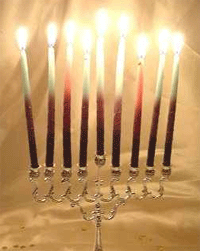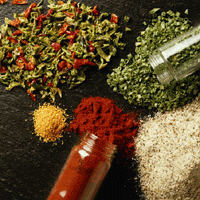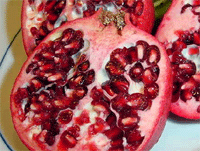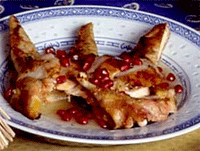Winter 2005: To Your Health
In this Issue:
- Specialty Holiday Coffee Drinks and Your Health
- Top 10 Ways to Survive Holiday Parties
- Chanukah…the Festival of Lights… and Potato Latkes
- Lowering Your Cholesterol Count
- Replacing Herbs and Spices for Fats in Cooking
- Exercising the Winter Blues Away
- Feature Food of the Month: Pomegranates
- Healthy Recipe: Roasted Pomegranate Chicken
Specialty Holiday Coffee Drinks and Your Health
 Grabbing that gourmet coffee this holiday season might be doing more than giving you that boost of energy. According to the National Coffee Association, 107 million American adults drink coffee every day, of which 29 million drink gourmet coffee. Starbucks is one of the most popular places to purchase these gourmet coffee drinks, and with the holiday season quickly approaching, the menu of delicious drinks offered is endless. Two of the seasonal drinks offered, the Pumpkin Spice Crème (with whipped cream) and the Peppermint Hot Chocolate offer great festive treats that will easily get you in the holiday spirit. What is not shown on the holiday menu board is that both of these drinks not only offer a cup of holiday cheer, but add an approximate 500 additional calories to your daily intake. In addition to the calories, there are at least 14 grams of fat in one 16 ounce cup of each of these holiday specials. These amounts of calories are the equivalent to approximately 1 fast food Quarter Pounder with cheese or an order of large fries.
Grabbing that gourmet coffee this holiday season might be doing more than giving you that boost of energy. According to the National Coffee Association, 107 million American adults drink coffee every day, of which 29 million drink gourmet coffee. Starbucks is one of the most popular places to purchase these gourmet coffee drinks, and with the holiday season quickly approaching, the menu of delicious drinks offered is endless. Two of the seasonal drinks offered, the Pumpkin Spice Crème (with whipped cream) and the Peppermint Hot Chocolate offer great festive treats that will easily get you in the holiday spirit. What is not shown on the holiday menu board is that both of these drinks not only offer a cup of holiday cheer, but add an approximate 500 additional calories to your daily intake. In addition to the calories, there are at least 14 grams of fat in one 16 ounce cup of each of these holiday specials. These amounts of calories are the equivalent to approximately 1 fast food Quarter Pounder with cheese or an order of large fries.
If it is the caffeine that you crave from coffee beverages, there are many health risks that have been shown to be associated with consuming excessive amounts of caffeinated products such as brewed coffee. Two separate studies have been released by the Journal of the American Medical Association, connecting increased caffeine consumption with a variety of health issues. The first article showed that a daily consumption of 24 oz. of filtered, caffeinated coffee leads to an increase in total cholesterol. The second article showed a correlation between coffee lovers who quit drinking caffeinated filtered coffee, and a decrease in cholesterol and homocysteine levels. These decreases could decrease the homocysteine-attributed risk of ischemic heart disease by approximately 10 % and cholesterol- attributed risk by 15%.
Some helpful hints to decrease your chances of the health risks associated with coffee and caffeine products are:
- Mix decaffeinated coffee with regular coffee
- Choose skim milk or reduced fat milk in your coffee
- Drink a latte with more low-fat milk than coffee
- Try to exercise in the morning for that natural boost of energy
References:
Stepherson, Joan. Jolting Java. JAMA. Chicago: Oct 2001. Vol 286, Issue 14; pg. 1704.??Fried, Foy E, Levine, David, et al. Effect of Filtered-Coffee Consumption on Plasma Lipid Levels. JAMA. Chicago: Feb 1992. Vol 267, Issue 6; pg 811.
Top 10 Ways to Survive Holiday Parties
 10: Survey the buffet before filling your plate. Make a mental note of healthy choices, then return to fill your plate. Fill half your plate with vegetables then select a few favorites to fill the other half of the plate.
10: Survey the buffet before filling your plate. Make a mental note of healthy choices, then return to fill your plate. Fill half your plate with vegetables then select a few favorites to fill the other half of the plate.
9: Position yourself away from the buffet table. Concentrate on the conversation instead.
8: Bring a healthful dish to share. Some favorite ideas include: tossed salad, vegetable platter, fresh fruit salad, pasta salad, platter of turkey sandwiches or vegetable soup.
7: Remember that alcohol increases appetite and contributes calories.
6: Make the first drink at a party low calorie; save the high calorie beverage for the end of the party.
5: Eat a small meal or snack before attending special events and parties.
4: Learn the art of saying “No, thank you. I’ll pass.”
3: Think first- “Do I really like/want/need this? Is this on my list of favorites?”
2: Taste next- Ask yourself, “Is it as good as I thought it would be?” If not, don’t eat it!
1: Practice Moderation, Not Deprivation!
Chanukah…the Festival of Lights… and Potato Latkes
 Chanukah means DEDICATION in Hebrew — the holiday pays tribute to the dedication of a group of Jews who believed fervently in their right to religious freedom. Also known as the “Festival of Lights,” Chanukah celebrates the miracle that occurred when the Maccabees reclaimed the Temple. The sanctuary was torn apart by the Syrian-Greek forces. The fighters found only enough oil to light a menorah (lantern) for one day. But the menorah blazed for eight full days. Chanukah is a holiday of renewed dedication, faith, hope and spiritual light. It’s a holiday that says “Never Lose Hope”!
Chanukah means DEDICATION in Hebrew — the holiday pays tribute to the dedication of a group of Jews who believed fervently in their right to religious freedom. Also known as the “Festival of Lights,” Chanukah celebrates the miracle that occurred when the Maccabees reclaimed the Temple. The sanctuary was torn apart by the Syrian-Greek forces. The fighters found only enough oil to light a menorah (lantern) for one day. But the menorah blazed for eight full days. Chanukah is a holiday of renewed dedication, faith, hope and spiritual light. It’s a holiday that says “Never Lose Hope”!
As you celebrate this special holiday season, you should be mindful of the important things in your life that you are dedicated to. One important issue that you should be dedicated to is your health and well being. As the strength of the oil kept the candles lit for eight full days, keep the strength in your heart to be committed to improving your own health. There may not be a magical quick fix, and there certainly is no “miracle” diet, but with enough dedication and spirit, you can achieve all of your goals.
Here are some “Magical” Steps to Weight Management for you to keep in mind when temptations may come your way. Never Lose Hope!
Think Positive!
- Believe that the magic is within the individual, not a fad diet or pill. YOU CAN DO IT!
The Right Strategies
- Eat only when you are hungry. Smaller, more frequent meals are better than one or two large ones, if you are trying to lose weight.
- Avoid fad diets- follow a healthy lifestyle.
- Stay hydrated by drinking at least 8-10 glasses of water per day.
- Eat a healthy breakfast every day.
- Exercise for at least 30 minutes most days a week.
- Make whole grains, fruits and vegetables the base of your meal plan.
Environmental Control
- Find a buddy or a group of friends who will commit themselves to change in lifestyle.
- Keep the right foods like fresh fruits and veggies, whole grains, nonfat dairy foods and lean meats on hand.
- Plan meals and make a shopping list so you eat more meals at home.
- Pick restaurants that offer a variety of healthy menu items such as vegetables, soups and salads.
- Try this recipe and turn an old Chanukah favorite into a healthy festive option:
POTATO LATKES
Ingredients:
4 medium potatoes, peeled & coarsely shredded
1 medium onion, coarsely grated
4 green onions, chopped (about a 1/2 cup)
Salt & ground pepper to taste
2 egg whites, beaten
1 tsp. canola oil
Nonstick cooking spray
Instructions:
- In a large bowl, mix potato with onion. Wrap mixture in paper towels and squeeze out all liquid over large measuring cup. Potato starch will settle to the bottom of measuring cup.
- Slowly pour off and discard liquid in measuring cup, reserving potato starch.
- In large bowl, combine potato mixture, green onions, egg whites, salt and pepper to taste, and reserved potato starch.
- Coat nonstick 12-inch skillet with 1 tsp. oil and cooking spray and heat skillet over medium-high heat.
- With hands, press together about 2 tablespoons potato mixture; place in skillet and flatten with wide metal spatula. Repeat with remaining potato mixture. Cook latkes about 8 minutes, turning once, until browned on both sides. Cover loosely with foil, keep warm.
Yield: 24 latkes
Serving Size: 2 latkes
Exchange: 1 starch
Nutrition Facts:?
Calories= 76
Fat= 0 gm
Cholesterol= 0 mg
Carbohydrate= 16 gm
Dietary Fiber= 1.5 gm
For another tasty latke recipe, click here.
Lowering Your Cholesterol Count
 A recent study published in The Journal of Nutrition compared the effects of three diets with different ratios of saturated fats and unsaturated fats on serum lipoprotein levels. The first diet was a high saturated fat diet (38% of calories), the second diet was a low total fat and saturated fat diet (19% of calories) and the third diet was a high unsaturated fat diet (38% of calories) consisting of both mono and polyunsaturated fats. The study consisted of 25 women who consumed each diet for a three week period of time. The study found that the serum total cholesterol and LDL did not differ between the high saturated fat and low saturated fat diet periods. Total cholesterol and LDL were lower when women consumed the high unsaturated fat diet than when they consumed the other two diets. The LDL/HDL cholesterol ratio was higher when women consumed either the low saturated fat diet or the high saturated fat diet than when they consumed the high unsaturated fat diet.
A recent study published in The Journal of Nutrition compared the effects of three diets with different ratios of saturated fats and unsaturated fats on serum lipoprotein levels. The first diet was a high saturated fat diet (38% of calories), the second diet was a low total fat and saturated fat diet (19% of calories) and the third diet was a high unsaturated fat diet (38% of calories) consisting of both mono and polyunsaturated fats. The study consisted of 25 women who consumed each diet for a three week period of time. The study found that the serum total cholesterol and LDL did not differ between the high saturated fat and low saturated fat diet periods. Total cholesterol and LDL were lower when women consumed the high unsaturated fat diet than when they consumed the other two diets. The LDL/HDL cholesterol ratio was higher when women consumed either the low saturated fat diet or the high saturated fat diet than when they consumed the high unsaturated fat diet.
The study concludes that to influence the LDL/HDL cholesterol ratio, changing the proportions of dietary fatty acids may be more important than restricting the percentage of total or saturated fat in the diet. High total or LDL cholesterol levels and a high LDL/HDL cholesterol ratio increases the incidence of atherosclerosis and heart attacks. Some great sources of monounsaturated and polyunsaturated fats to incorporate into your diet are olive oil, canola oil, avocados, nuts, seeds and flaxseed.
Reference:
Muller, H. et al. The Serum LDL/HDL Cholesterol Ratio is Influenced More Favorably by Exchanging Saturated with Unsaturated Fat than by Reducing Saturated Fat in the Diet of Women. The Journal of Nutrition, Jan 2003 v133 il pg 78(6).
Replacing Herbs and Spices for Fats in Cooking
 There are countless recipes that have been handed down through the generations. Each recipe carries our ancestor’s cultures through time, but unfortunately generations ago the knowledge on how to prevent illnesses and diseases through nutrition was not as clear as it is today. Many of these recipes contain a high content of both total fat and saturated fat because of the use of fats and lards in the cooking process. A diet high in saturated fats increases the risk of cardiovascular complications, compared to that of a diet low in saturated fats.
There are countless recipes that have been handed down through the generations. Each recipe carries our ancestor’s cultures through time, but unfortunately generations ago the knowledge on how to prevent illnesses and diseases through nutrition was not as clear as it is today. Many of these recipes contain a high content of both total fat and saturated fat because of the use of fats and lards in the cooking process. A diet high in saturated fats increases the risk of cardiovascular complications, compared to that of a diet low in saturated fats.
So how does one keep the high quality tastes that we love while cutting down on the fats? One answer to this question is increasing the use of different spices and herbs in our favorite recipes to make them both tasty and good for your health.
According to three recent studies published in the American Journal of Clinical Nutrition, Journal of Nutrition and Journal of Food Science, the power of herbs and spices in a balanced diet showed such benefits as reducing the risk of cardiovascular disease and cancer, as well as significant protection against chronic conditions. What makes herbs and spices so special are the high levels of phytochemicals present in the plants that herbs come from. These phytochemicals have antioxidant properties which clear free radicals out of the body that have the potential to cause cancer and heart disease among other ailments.
Some examples of herbs with very high concentrations of antioxidants are oregano, sage, peppermint, garden thyme, lemon balm, clove, allspice and cinnamon. Antioxidant and anti-inflammatory properties have also been found in ginger, red pepper, garlic, green onion, and leek.
Helpful Tips for Cooking with Herbs and Spices
- Dried herbs are stronger than fresh. A useful tool to use when using herbs and spices is 1 tablespoon finely cut fresh herbs is = 1 teaspoon crumbled dried herbs = ¼ – ½ teaspoon ground dried herbs.
- Leaves should be chopped very fine because the more cut surface exposed the more flavor will be absorbed.
- Be conservative in the amount of an herb used until you’re familiar with its strength.
- The flavoring of herbs is lost by extended cooking. Add herbs to soups or stews about 45 minutes before completing the cooking.
- When served in a cold dish, such as a marinade, dip or dressing, it is best to add the herbs the night before.
- To become familiar with a specific flavor of an herb, try mixing it with cream cheese, let it sit for an hour, and spread on a plain cracker.
- Beware of herbal salt blends, such as garlic salt, because they are merely herbs added to salt. Read the ingredients carefully.
- Keep herbs and spices in a cool dry place away from the sun. Store them in plastic bags, boxes or tins. Don’t store them on shelves above the stove because the heat affects the aromas of the herbs.
- Spices should be checked at least once a year for fresh aroma and color.
For more tips on cooking with herbs and spices, click here.
References:
Craig, W. Health-promoting properties of common herbs. American Journal of Clinical Nutrition, Sept 1999 v70 i3 pg 491S.
Dragland, S et al. Several culinary and medicinal herbs are important sources of dietary antioxidants. Journal of Nutrition, May 2003 v 133 i5 p1286(5).
Lampe, J. Spicing up a vegetarian diet: chemopreventive effects of phytochemicals. American Journal of Clinical Nutrition, Sep 2003 v78 i3 p579S(5)??Holly H. Shimizu, curator of the herb garden at the U.S. National Arboretum in Washington D.C.
Exercising the Winter Blues Away
 Looking for a way to shake off those winter blues, improve your mood, improve your sleep and boost your energy level? Well, there is one answer that helps with all of those problems…EXERCISE. Even though the cold weather and winter blues may make you feel like hibernating, it is important not to give up your exercise and fitness goals. Set aside at least 30 minutes or more a day for physical activity. You can even spread the 30 minutes throughout the day if this is easier for you.
Looking for a way to shake off those winter blues, improve your mood, improve your sleep and boost your energy level? Well, there is one answer that helps with all of those problems…EXERCISE. Even though the cold weather and winter blues may make you feel like hibernating, it is important not to give up your exercise and fitness goals. Set aside at least 30 minutes or more a day for physical activity. You can even spread the 30 minutes throughout the day if this is easier for you.
Great Ideas for Exercising Indoors
- Join a health club. Take some fun exercise classes where you not only exercise, but socialize!
- Walk at the mall. Use the escalators less and the stairs more. For an added challenge, bring along some weights and do lifts while you are walking.
- Do some work around the house. Garden, sweep, clean the bathtub…anything that will get your body moving is considered exercise.
- Swim at your local indoor pool. Working out in water is easier on your joints than most other forms of exercise.
- Buy a piece of exercise equipment. Find a piece of equipment that is practical, easy to use and enjoyable. This will ensure that you will continue to use it.
- Dance. Put on your favorite CD, close your door and dance for 30 minutes.
Exercising Outdoors during the Winter
For the more adventurous who enjoy exercising outdoors, there are some techniques to remember to make exercising both a comfortable and safe activity:
- Layer properly! The Mayo Clinic suggests wearing three layers. The first layer, closest to your skin, should be a layer of synthetic microfibers, such as polypropylene, which draws sweat away from your body. Avoid cotton, which absorbs and holds moisture close to your body. The second layer provides insulation. Try fleece, a lightweight, quick-drying material that provides good insulation. Your third layer, if it is really cold, should be windproof and waterproof. You don’t want to be weighed down by your clothes, but you also want to be protected from the cold.
- Don’t forget to protect your feet and hands properly. Use gloves or mittens that have the same three layer system described above. Mittens tend to be warmer than gloves because they retain more heat around your fingers. Wool or polypropylene socks are a good choice for insulating your feet. Purchase all-climate shoes that are water-resistant with soles that provide traction and stability.
- You can lose a lot of body heat through your head if your head is exposed to the cold weather. A wool or fleece hat that draws the perspiration away from your head is advisable.
- Glasses or goggles should be worn to protect your eyes from the wind and ultraviolet radiation.
- Even though it might be cold out, it is still important to wear sunscreen and lip balm with sunscreen to protect your skin and lips.
Always check with your doctor before beginning any exercise program.
For Tips on Exercising Safely Outdoors in the Winter, please visit our Special web section.
Feature Food of the Month – Pomegranates
 Pomegranates have been highly revered since the time of the ancient Israelites. Their seeds are said to number 613- one for each of the Bible’s 613 commandments (British Medical Journal). The pomegranate was revered for the beauty of it’s shrub, flower and fruit and was used to decorate the pillars of King Solomon’s temple and the robes of Jewish kings. ??Pomegranates are regaining their popularity for the numerous health benefits that these delicious fruits offer. These fruits are rich in iron, and Vitamins A, C, and E. ??So what exactly can the pomegranates do for you if they are incorporated into your diet?
Pomegranates have been highly revered since the time of the ancient Israelites. Their seeds are said to number 613- one for each of the Bible’s 613 commandments (British Medical Journal). The pomegranate was revered for the beauty of it’s shrub, flower and fruit and was used to decorate the pillars of King Solomon’s temple and the robes of Jewish kings. ??Pomegranates are regaining their popularity for the numerous health benefits that these delicious fruits offer. These fruits are rich in iron, and Vitamins A, C, and E. ??So what exactly can the pomegranates do for you if they are incorporated into your diet?
- According to the Proceedings of the National Academy of Sciences of the Unites States, pomegranate juice may help in preventing prostate cancer.
- According to a study in the American Journal of Clinical Nutrition, pomegranate juice has antiatherogenic effects. Atherogenesis is the underlying cause of not only coronary artery disease but of arterial disease throughout the body, and pomegranate juice reduces the incidence of atherogenesis.
- The pomegranate has been found to decrease LDL or “bad cholesterol”.
- Drinking one glass of pomegranate juice a day has been found to increase the blood flow to the heart by 17%, and may cut the progression of coronary heart disease.
References:
Aviram, M. et al. Pomegranate juice consumption reduces oxidative stress, atherogenic modifications to LDL, and platelet aggregation: studies in humans and in atherosclerotic apolipoprotein E-deficient mice. American Journal of Clinical Nutrition, May 200 v71 pg 1062.??Langley. Why a pomegranate? British Medical Journal, Nov 2000 v 321 I7269 pg 1153
Pick a Pomegranate. Better Nutrition, Feb 2005 vol 67 i2, p14
Nigris, F. et al. Beneficial effects of pomegranate juice on oxidation-sensitive genes and endothelial nitric oxide synthase activity at sites of perturbed shear stress. Proceedings of the National Academy of Sciences of the Unites States, March 2005 v102 i13 pg 4896(6)
Malik, A. et al. Pomegranate fruit juice for chemoprevention and chemotherapy of prostate cancer. Proceedings of the National Academy of Sciences of the Unites States, Oct 2005 v102 i41 pg 14813(6)
Healthy Recipe: Roasted Pomegranate Chicken
 Ingredients:
Ingredients:
1 tablespoon olive oil
1 tablespoon minced garlic
1 (3 1/2 to 4-pound) chicken, quartered
1 pomegranate, halved
1/4 cup dry white wine
Juice of 1 lemon
2 teaspoons white granulated sugar
1 teaspoon cinnamon
Salt and pepper
Instructions:
- Preheat oven to 375 degrees Fahrenheit. Take the skin off of the chicken. In a small bowl, mix oil and garlic. Brush over chicken.
- Place chicken in a shallow baking dish. Bake in preheated oven for 45 minutes, basting several times with pan juices, until chicken is browned and juices run clear when a thigh is pierced at thickest part with a fork.
- Remove 1 tablespoon seeds from pomegranate. Set aside for garnish. Squeeze juice from remaining pomegranate through a sieve into a small bowl.
- In a small saucepan, mix pomegranate juice, wine, lemon juice, sugar and cinnamon. Bring to a boil over high heat. Reduce heat to low and cook 5 minutes. Season sauce with salt and pepper to taste.
- Transfer roasted chicken to a serving platter and pierce each piece several times. Pour sauce over chicken. Garnish with pomegranate seeds and serve at room temperature.
Yield:
4 Servings
Serving Size:
1 Chicken Quarter
Exchanges: 6 Meat, 1/2 Fruit
Nutrition Facts:
Calories = 322
Total Fat = 14 grams
Saturated Fat = 4 grams
Cholesterol = 171 milligrams
Protein = 44 grams
Carbohydrate = 5 grams
Sodium = 346 milligrams?Dietary Fiber = 0 grams
Credits:
Recipe from: Everyday Cooking for the Jewish Home by Ethel G. Hofman. Modified by Bonnie R. Giller, MS, RD, CDN, CDE
For more healthy recipes, click here.

Leave a Reply
Want to join the discussion?Feel free to contribute!